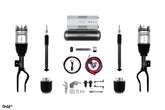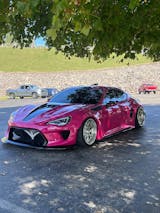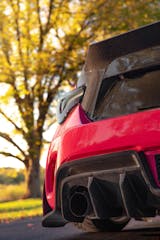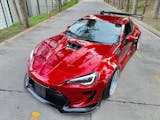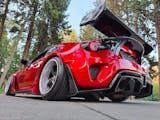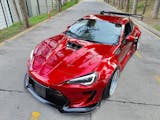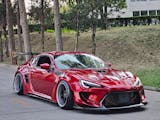FRP (Fiberglass Reinforced Plastic) Body Kits:
FRP or Fiberglass Reinforced Plastic is predominantly used in the production of body kits. A common misconception is that it’s entirely made of “plastic.” However, FRP is largely composed of fibreglass, which solidifies upon the addition of a polyester-based resin. Many FRP kits have a gel coat finish, while others might just have a primer coating. The primary reasons for its extensive use include its affordable manufacturing cost and the ease with which the parts can be modified.
Clarification on FRP Characteristics: It’s pivotal to recognise that characteristics like scratches, sand weaves, and join lines in FRP parts are standard outcomes of their production. It’s not a sign of inferior quality. Such features are intrinsic to all FRP parts, regardless of who makes them. Properly prepping these components is vital before painting or vinyl wrapping. This ensures a smooth, impeccable finish, thus amplifying the part’s visual allure and safeguarding it. Therefore, when you spot such traits, comprehend that they aren’t defects – they’re typical of FRP parts.
Special Note: White FRP, particularly from Robot, is smoother than its black counterpart. This means it often requires less prep work before painting. However, producing the white FRP is a more challenging process, making it slightly rare.
All FRP body kits need some level of cleaning and detailed attention before painting. The primary drawback is their susceptibility to damage if there’s an impact. However, they have the advantage of being budget-friendly and repairable.
Polyurethane (PP) Body Kits:
Polyurethane takes the second spot in terms of popularity for body kit materials. Known for its rubber-like texture, polyurethane stands out for its immense flexibility and durability. Unlike a fibreglass bumper, a polyurethane bumper can endure impacts without significant damage. On the downside, polyurethane kits are pricier to manufacture. The production method and mould designs add to the expense, making these kits less widespread than fibreglass ones. Additionally, polyurethane parts weigh more, often necessitating support brackets to avoid sagging.
Carbon Fiber Body Kits
Carbon Fiber Reinforced Polymer (CFRP) is the premium choice for body kits. These kits exude luxury with their glossy protective finish over the carbon fiber weave. Unlike traditional materials, CFRP doesn't require painting but could benefit from a UV-protective clear coat. This material is mostly chosen for components like bonnets, bumper lips, side skirts, and spoilers, where strength and lightness are crucial.
What is CFRP? CFRP stands for Carbon Fiber Reinforced Polymer. This material is a composite, meaning it is made from two or more different materials that, when combined, produce a product with characteristics different from the individual components. In the case of CFRP, the materials are carbon fibers and a polymer, usually an epoxy resin. The carbon fibers provide the strength and stiffness, while the polymer binds the fibers together and gives the composite its shape and bulk.
What is Dry Carbon? Dry carbon fiber is a similar composite material but differs significantly in its manufacturing process and resulting properties. Dry carbon is made using pre-preg carbon fiber that is impregnated with resin at a factory level and then cured in an autoclave under high heat and pressure. This process removes more air and results in a carbon fiber part that is lighter and has a higher specific stiffness than CFRP, which is typically produced by layering wet carbon fiber into a mold and then curing it without the same level of heat and pressure.
Differences Between CFRP and Dry Carbon
- Manufacturing Process: CFRP often uses a wet layup process, where the carbon fiber is layered manually and resin is applied before the curing process. Dry carbon uses pre-preg materials and requires autoclave curing, leading to fewer impurities and a more controlled process.
- Weight: Dry carbon is generally lighter than CFRP due to its more refined manufacturing process, which reduces resin content and removes trapped air more effectively.
- Strength and Stiffness: Due to the high-pressure and high-temperature curing process, dry carbon tends to be stronger and stiffer than CFRP.
- Cost: The advanced manufacturing process of dry carbon makes it more expensive than CFRP. This cost can be a significant factor when choosing materials for automotive body kits.
- Finish and Appearance: Both materials can feature the distinctive carbon fiber weave, but the finish on dry carbon is often considered to be more premium due to the material's higher quality and the precision of the manufacturing process.
Choosing Between CFRP and Dry Carbon The choice between CFRP and dry carbon often comes down to the specific needs of the vehicle and budget constraints. For automotive enthusiasts who prioritize ultimate performance and can afford the extra cost, dry carbon is the superior option. However, for most applications, CFRP provides a good balance of performance, aesthetics, and cost.
By understanding these differences, you can better appreciate the unique benefits of each type of carbon fiber and why they are highly valued in the design of high-performance automotive parts.
The Installation Process for Body Kits
“How do I install my body kit?” is a frequent query. Generally, full bumper replacement kits utilize the original equipment manufacturer (OEM) hardware from stock bumpers. The first step involves a dry fit to check alignment. Post this, you’d mark and drill mounting holes.
Tip: When drilling fibreglass, apply masking tape over the intended area and drill in reverse to prevent splintering.
Ensure the component is aligned right and all flaws are marked for rectification. For heavier polyurethane kits, custom brackets might be essential for proper support.
Choosing the Right Body Shop
Opt for customisation-centric shops over collision repair ones. Custom shops, familiar with body kits and unique paint jobs, are better equipped for such tasks.
Prepping Your Body Kit for Paint
Body kits aren’t always paint-ready. FRP kits need extensive prep – sanding, spotting defects, and using body filler for a smooth surface. Polyurethane parts require less work but need an adhesion promoter for paint bonding and a flex agent for paint flexibility. Carbon fibre kits, though not requiring paint, benefit from an automotive clear coat for a deeper finish and UV protection.









































































































